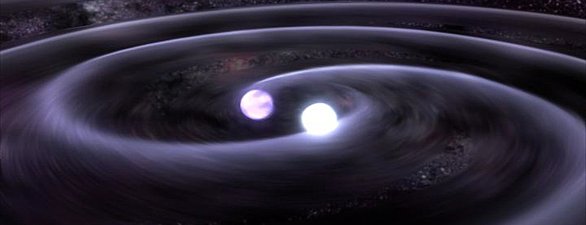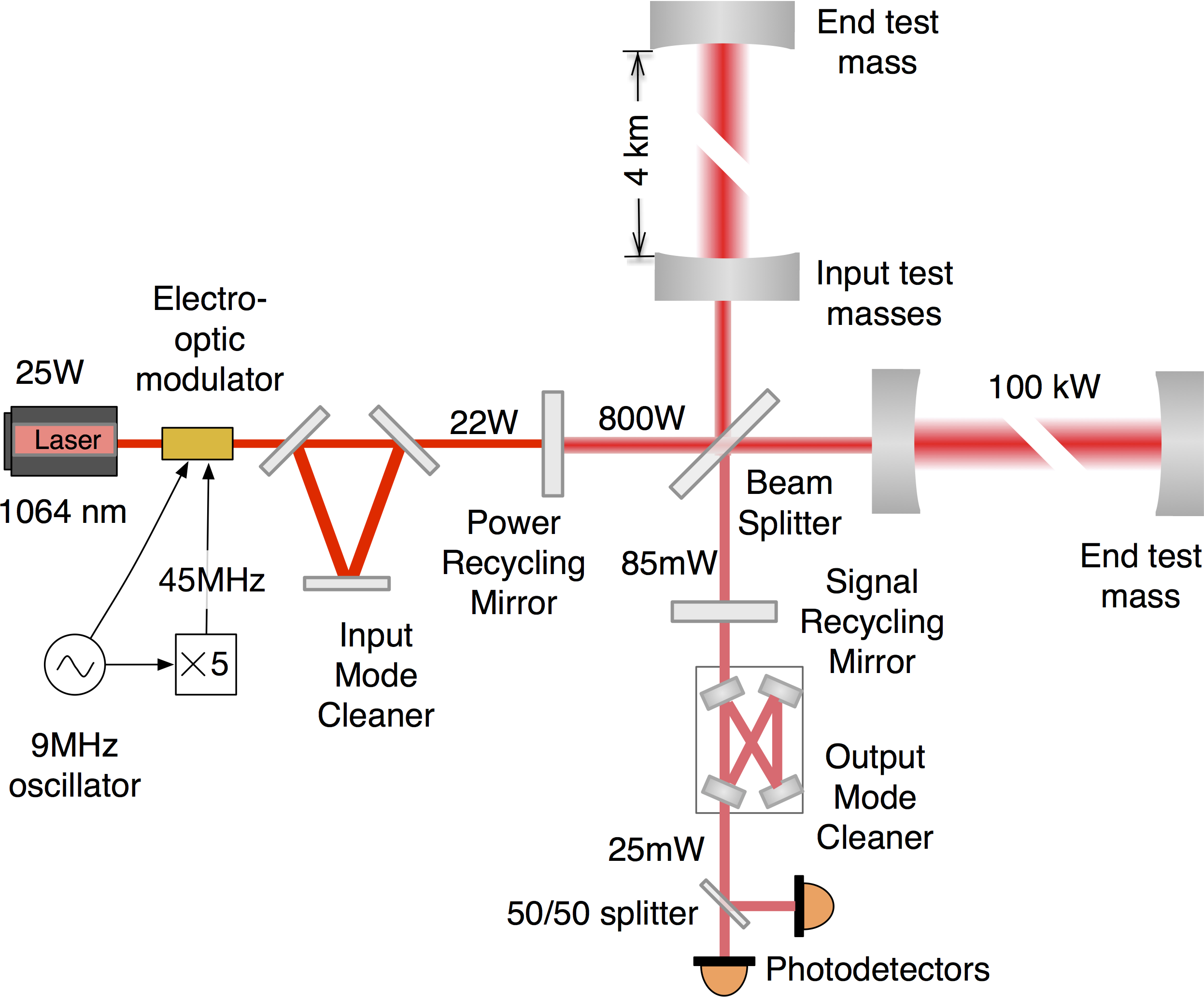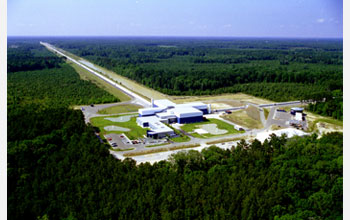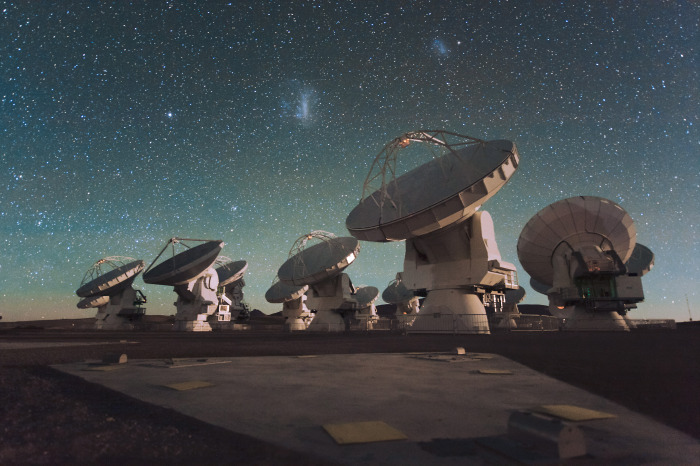Brightest Flashes in the Universe
science·@n3bul4·
0.000 HBDBrightest Flashes in the Universe
# <center>Gravitational wave of an outbreak of gamma radiation measured?</center> <br> **According to rumors, the gravitational wave observatory LIGO has caught one of the equally gigantic as enigmatic gamma ray bursts in the act.** <br> <center><br><code>© NASA / Dana Berry, SkyWorks Digital </code></center> <br> Gravitational waves of two colliding neutron stars in a distant galaxy may have been captured by astrophysicists last week with the LIGO detector - and even telescopes investigating the same area of the sky might have detected the event. <div class="pull-right"> <code>The Advanced LIGO detectors are Michelson interferometers with 4-km long arms. © ligo.org</code> </div> There are currently many rumors about the possible discovery online. Researchers from all over the world are looking forward to it. Such a measurement could open up a new era in astronomy: phenomena are not only seen by traditional telescopes, but are also "heard" by vibrations of space. >It would be a great advance for our understanding, says Stuart Shapiro, University of Illinois astrophysicist in Urbana-Champaign. Gravitational wave researchers did not comment on the rumors so far, since they are still investigating the data. According to publicly observable records, telescopes around the world observed that galaxy in which the two neutron stars collided. However, astronomers warn that they might have investigated a different event. <br> ### What are the rumors? <br> <div class="pull-left">  <code>LIGO Livingston Observatory<br>© nsf.gov</code> </div> The gravitational wave observatory LIGO in the USA has so far been [proven gravitational waves - ripples in space- three times](https://www.nature.com/news/ligo-spots-gravitational-waves-for-third-time-1.22093), which arose after the collision of two black holes. However, scientists hoped to detect bumps of other cosmic events, such as the fusion of neutron stars - the survival of exploded heavy stars that were not heavy enough to collapse as a black hole. Such an event should also emit radiation from the entire electromagnetic spectrum from radio waves to gamma rays that telescopes can record. On 18th August the astronomer J. Craig Wheeler from the University of Texas in Austin poured oil into the fire of the rumored kitchen when he twittered the following statement: >New LIGO. Source with optical counterpart. Blow your sox off! An hour later, the astronomer Peter Yoachim of the University of Washington in Seattle tweeted that LIGO detected an event with a telescopes visible optical signal in the galaxy NGC 4993, which is about 40 million parsec (130 million light years) away from us in the southern Constellation of Hydra. >Merging of two neutron stars is the first assessment, followed by him. As astronomers report, who want to remain anonymous, private first rumors circulated already before Wheelers and Yoachims Tweet. If gravitational wave researchers discovered a signal, it is plausible that they could very quickly assess their origin: Whether two colliding black holes or neutron stars, each event has its own manuscript. However, the researchers must carefully examine their data to determine the origin of the event accurately. It is also possible that [LIGO's underdog cousin observatory Virgo in Pisa](https://www.nature.com/news/ligo-s-underdog-cousin-ready-to-enhance-gravitational-wave-hunt-1.21437), which LIGO has been supporting since August after a long break in the search for gravitational waves, detected the event. This allows researchers to identify the source even more precisely. Virgo is not sensitive enough in fusions of neutron stars to identify sources beyond distances ranging from 25 to 27 million parsec on average. However, in some areas of the sky, signals from up to 60 million parsec could be intercepted, says physicist Giovanni Losurdo, who headed the expansion of the detector. Both Wheeler and Yoachim refused to comment. Later, Wheeler apologized on Twitter, >Right or wrong, I should not have sent this tweet, LIGO deserves the announcement as soon as they think it appropriate. <br> ### What have telescopes observed? <br> Anonymous astronomers cite rumors that NASA's gamma-ray telescope Fermi spotted gamma rays originating from the same region as the potential gravitational wave source. A leading member of Fermi declined to comment. These observations fit the assumption that collisions of neutron stars are responsible for the enigmatic phenomenon of the gamma ray. These extreme radiation bursts last a few seconds, followed by a tingling afterglow in visible light, as well as radii waves and x-rays. But astronomers warn: Even if the Fermi telescope recorded gamma rays, it would not be possible to determine their exact origin. <br> <center><br><code>ALMA telescope under the Magellanic Clouds © ESO/C. Malin / ALMA / CC BY 4.0 CC BY</code></center> <br> However, more and more indicates that after a call, telescopes around the world examined the galaxy NGC 4993 for the event. According to a tweet released by SpaceTelescope Live on Aug. 22, some astronomers observed the fusion of two neutron stars using the spectrograph in the Hubble telescope. This instrument is commonly used by researchers to observe the afterglow of gamma rays. The tweet has been deleted. According to a [commentary published on 23rd August in the blog of the astrophysicist Peter Coles](https://telescoper.wordpress.com/2017/08/23/ligo-leaks-and-ngc-4993/) of Cardiff University in England, NASA's X-ray observatory, NASA, had also taken the search. The website of Chandra contains publicly observable records of an observation of 19th of August. The telescope peered to the galaxy NGC 4993 to observe an event called SGRB170817A - the abbreviation stands for "Short Gamma Ray Burst on 17 August 2017". The most exciting part of the report lies in the "trigger criteria" which indicate the reason for a change in the intended observation direction. This says: >Gravitational wave source detected by LIGO, VIRGO or both. Publicly observable records of other large astronomical facilities - including the Very Large Telescope of the European Southern Observatory and the world's first radio telescope in the Atacama Large Millimeter Array (ALMA) in Chile - show that they also observed NGC 4993 on 18th and 19th of August. <br> https://www.youtube.com/watch?v=B4XzLDM3Py8<center><code>LIGO Detects Gravitational Waves © MIT</code></center> <br> ### What could we learn from the merger of neutron stars? <br> Gravitational wave signals from the fusion of black holes are short - typically lasting less than a second. A fusion of neutron stars, on the other hand, could produce a signal lasting up to one minute, since neutron stars are lighter than black holes. They therefore give off weaker gravitational waves and thus need longer to collide with each other. Longer-lasting events allow much more precise tests by Albert Einstein's General Relativity Theory, which predicts gravitational waves, which may give us more clues about the formation of neutron stars. The short gamma rays observed by the telescopes, according to the rumors, would also be significant - they could confirm astrophysical theories about the interrelationship of gamma rays and neutron star collisions. >Only gravitational waves can give us the beating proof, says Eleanora Troy, astrophysicist at NASA's Goddard Space Flight Center in Greenbelt, Maryland. Nevertheless, a short gamma-ray burst would already be an important discovery. NGC 4993 - 40 million Parsec away - would be the next short gamma ray burst ever recorded, says the astrophysicist Derek Fox of Pennsylvania State University. Most of such events are observed in the distant universe, billions of parsec away. The details of the gravitational waves during the collision and the subsequent moments could also reveal information about the structure of neutron stars, which is largely unknown until now. In addition, it would be possible to clarify whether their fusion again produces a neutron star or produces a black hole. <br> ### When will we know more? <br> On 25th August, LIGO and Virgo end their current data collection, according to which the researchers will only post a "top-level update". This is a short note that shows whether LIGO detected potential events, says David Shoemaker, a physicist at the Massachusetts Institute of Technology and LIGO's press reviewer. >It will take a while to meet the data and make sure that we can publish a credible result, he says. <br> <center>*Stay tuned for a follow up...*</center> <br> <center>https://steemitimages.com/0x0/https://steemitimages.com/0x0/https://steemitimages.com/0x0/https://steemitimages.com/0x0/https://steemitimages.com/0x0/https://steemitimages.com/0x0/https://steemitimages.com/0x0/https://steemitimages.com/0x0/https://steemitimages.com/0x0/https://steemitimages.com/0x0/https://steemitimages.com/0x0/https://steemitimages.com/0x0/https://steemitimages.com/0x0/https://steemitimages.com/0x0/https://steemitimages.com/0x0/https://steemitimages.com/0x0/https://steemitimages.com/0x0/https://steemitimages.com/0x0/https://steemitimages.com/0x0/https://steemitimages.com/0x0/https://steemitimages.com/0x0/https://steemitimages.com/0x0/https://steemitimages.com/0x0/https://steemitimages.com/0x0/https://steemitimages.com/0x0/https://steemitimages.com/DQmRhDtjokAZnGKi4QwheqksKTFo6m4fsjMYsNNrsitC1xk/U5dsnt2Y19qmNJ6S4rHWGSU4yi4wucH.gif</center>
👍 n3bul4, randowhale, randowhaletrail, cheftony, albertogm, fyrstikken, sqube, colinbrazendale, pf-coin, steve123, onlyoneman, showtime, treasuregnome, transhuman, ervin-lemark, heelzkinu, eutectico, philip.willemse, phunke, fancy-artists, randyw, ghasemkiani, inarix03, holoz0r, steemthat, banjo, minnowsupport, cryptoninja, nettybot, bendelgreco, buildawhale, discordia, booster, mcw, endaksi1, edrivegom, steemprentice, manandezo, singa, shawnfishbit, beng05, timbalabuch, taica, cryptohustler, tinashe, diggerdugg, gamerveda, markfitzgerald, bluchr, glex, arthestically, elyaque, stephen.king989, allyouneedtoknow, jhermanbeans, starrkravenmaf, soushi888, lastminuteman, pomperipossa, libertylol, sixexgames, numpypython, jhagi.bhai, gindor, whatamidoing, cryptastic, qwasert, pusteblume, jean.racines, burnedpixel, andrewgenaille, n1kofi, ch00fy, stella87s, myday, nesbitt, resiliencia, cryptogee,